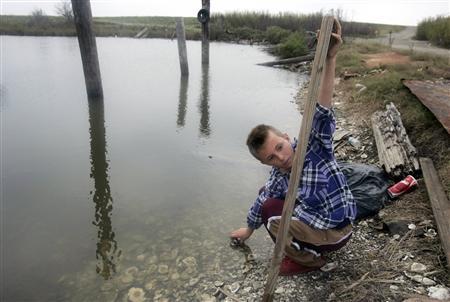|
|
|
Amigos w/ Common Interests
|
|
|
|
|
|
|
|
|
|
|
|
|
|
|
|
|
|
<<
View Prev Image
|
|
|
|
View Next Image >>
|

Category: Gloom and Doom |
|
|
Gavin Hamilton plays on a bayou shore in Empire, Louisiana December 18, 2006. REUTERS
Tip of Louisiana falls off recovery map
Wed Dec 27, 2006 7:51 AM ET
EMPIRE, Louisiana (Reuters) - Life on the bayou looks pretty sweet as the Hamilton family's oyster boat comes to dock. The sun bounces off blue water, the boat is full of plump oysters, the buyer is ready to load and three generations are happy with the day's work.
With sun-baked faces and mud-speckled clothes, they head for home, a place that is not so sweet. Home for the six is two trailers from the Federal Emergency Management Agency parked below an earthen levee that separates them from the mighty Mississippi, just miles from the river mouth.
That's life for most of the few thousand who reside in lower Plaquemines Parish, 50 miles south of New Orleans, where Hurricane Katrina made landfall 16 months ago, ripping everything on the narrow watery strip between the river and the Gulf of Mexico to shreds. These people have weathered many a storm. When Betsy, Camille, Flossie, and others came through, they would tie their boats to trees and ride out the hurricane in the cabins.
But Katrina was bound to be different and almost everyone evacuated. With the erosion of wetlands and barrier islands over the years, there was little to stop the storm before it hit with brute force. And because wind and flooding damage was so extensive, destroying much of New Orleans and the Mississippi Gulf Coast, money for rebuilding has been slow to come.
Now many fear it will never come.
As plans stand, the Army Corps of Engineers is not likely to advocate spending $1.6 billion to build higher levees in south Plaquemines. Those who stay will have to raise their homes up 14 feet to be eligible for federal flood insurance.
The master plan to be finalized in 2007 also envisages making diversions in the Mississippi to slow erosion, which would put fresh water into the salt water estuary and possibly endanger the world-famous seafood and fishing at the heart of Plaquemines.
"From day one, I felt like the government officials didn't want us down here anymore," said Lonnie Hamilton, 59, head of the three-generation oystering clan.
But his family is too tied to the ways of the bayou and refuses to budge. "I won't be run from my home," said daughter Cathy Bosarge, 34. "Since I can remember, I was an oyster brat."
Her sons also got the bayou bug, and even though they hate their FEMA trailer they love being on the boat. They convinced their mother to return after a year as evacuees in Alabama.
That kind of determination runs through the people of Plaquemines, a mix of European, African American and Asian people whose families have been here for generations.
At a public hearing in mid-December with Louisiana state coastal planners in Belle Chasse, the largest town in the safer upper Plaquemines, the normally stoic people from "down the road" were up in arms.
"If you put in that kind of diversion, I don't want to live down here anymore. You are ruining my life and I have no reason to stay," said John Tesvich, 49, who also works in the Empire oyster industry.
Building miles of higher levees for some 4,000 people might not make economic sense, but residents say there is also a thriving economy to protect -- the offshore oil and gas production, commercial seafood and sport fishing tourism.
Former parish sheriff Barney Schoenberger, 81, reminded the planners that Plaquemines deserves to be a rebuilt because of what it has given in economic riches in the past. "Plaquemines Parish down through the years has filled the treasuries of the state of Louisiana and the United States and we have seen very, very little in return," he said.
"We don't even have tin-can trailers for all our people. That is how much the federal government is taking care of us."
This month, with intense lobbying from the Gulf Coast states, President George W. Bush signed a law to open up 8.3 million acres to new oil and gas production that will give Louisiana for the first time a share of revenue for coastal protection -- an estimated $13 billion over 30 years.
But there are no guarantees Plaquemines will get what it wants or needs in coastal restoration.
With hundreds of thousands still displaced in New Orleans and a city below sea level to protect up there, lower Plaquemines feels low on the totem pole.
"Our opinions aren't going to make much difference in what they are going to do," said Bosarge.
With schools, fire stations, clinics, restaurants and supermarkets still in tatters and good services a good hour away, visitors can't help but wonder why the locals want to remain on this precarious spit of land.
"It takes a specific type to inhabit the end of the world," said Luke Ippoliti, who heads up a disaster relief center for the non-governmental organization Emergency Communities in Buras, where the eye of the hurricane hit.
last of article belo |
|
|
|
|
|
| |
|
|
|
|
|